
One of the more stressful and dangerous parts of the city for people walking, biking and rolling is, ironically, the medical nerve center for the State of Illinois. But that could be about to change, thanks to a plan recently issued by the Illinois Medical District Commission. The IMD Bicycle and Pedestrian Safety Plan outlines five projects to improve the transportation experience for tens of thousands of patients, medical professionals, students and residents who pass through the district each day.
The IMD is bounded by Congress Parkway on the north, 14th Street on the south, Ashland Avenue to the east and Oakley Avenue to the west and encompasses more than 40 medical facilities. It’s a busy patch of the city, buzzing with car and foot traffic. It’s also carved up by wide streets with fast-moving vehicles. Ogden Avenue slices northeast/southwest through the grid creating vast, wide-angled intersections that allow drivers to turn at high speeds. Damen Avenue expands to four wide lanes with a median for the five-eighths of a mile through the IMD. Congress Parkway is the service drive for I-290 and drivers exiting the expressway are given little incentive to slow down as they enter the district.
All this adds up to dangerous conditions for pedestrians and bicyclists. According to the plan, 100 people were seriously injured and five killed in traffic crashes in the IMD from 2017 to 2021. Crash hot spots are clustered along Damen, Ogden, Ashland Avenue, Wood Street and Harrison Street.
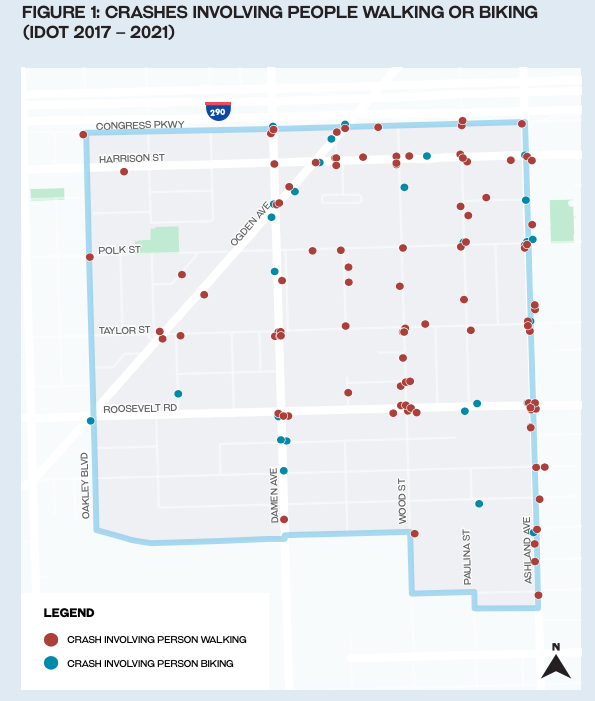
The plan recommends five projects to improve safety and walkability in the IMD. The first pedestrianizes the short block of Wolcott Avenue between Ogden and Harrison. The little triangle of land bounded by these three streets is currently barren and too small to develop. The plan envisions closing Wolcott to cars, uniting that parcel with the greenspace home to the Louis Pasteur statue, directly east. New landscaping, signage, street furniture, and ground murals on Wolcott would create a public plaza and visual gateway to the district. It might also be a cue to drivers fresh off the Eisenhower to slow down.
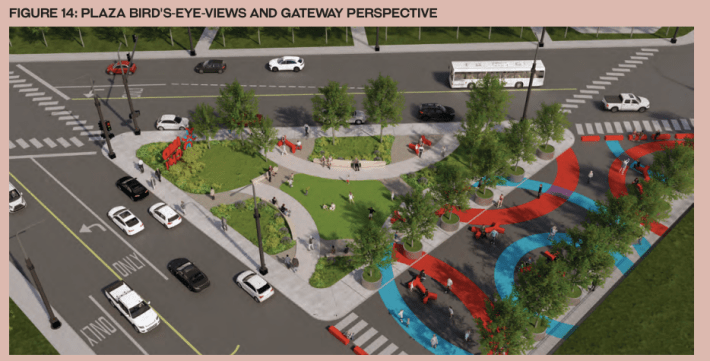
The second project repurposes the service drive on the east side of Damen between Polk and Taylor Streets into a “fitness loop,” connecting with a wide parkway and winding sidewalk that picks up south of Taylor Street. Renderings in the plan show landscaping to further separate pedestrians from traffic on Damen, ground murals on the service drive and a couple of fitness plazas along the route. Ultimately, the plan envisions extending the fitness loop all the way to Roosevelt, developing an underused parking lot owned by the State of Illinois Center for Rehabilitation Services. However, the plan states that Illinois representatives “could not be reached for engagement” at the time of writing.
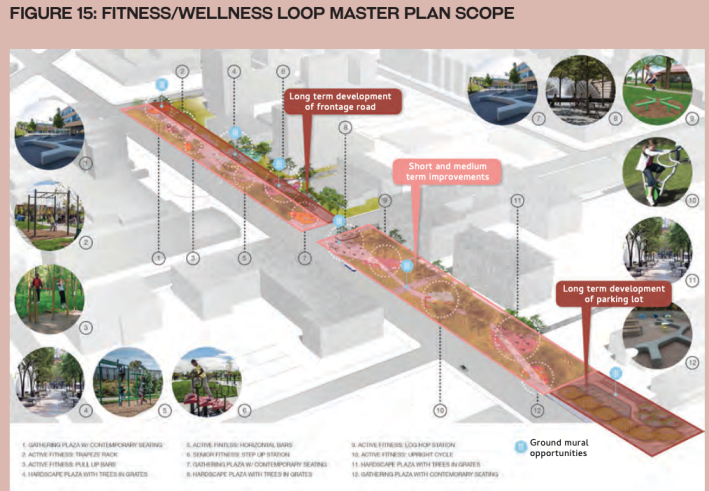
The third and perhaps most — as the plan dubs them – transformative project, is a Damen Avenue road diet from Roosevelt to Congress Parkway. Damen expands to four wide travel lanes through the IMD and has narrow, paint-only bike lanes. The Chicago Department of Transportation has identified this stretch of Damen for protected bike lanes and plans to install a mid-block pedestrian crossing at the Jesse Brown VA Medical Center. The IMD plan proposes incorporating these changes along with pedestrian refuge islands, curb bump outs and other traffic calming measures. The width and, in some places, number of vehicle travel lanes is reduced.
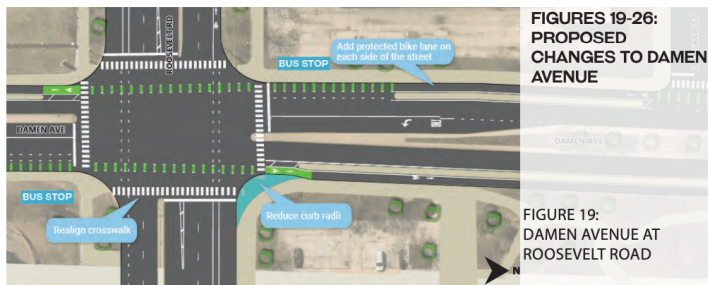
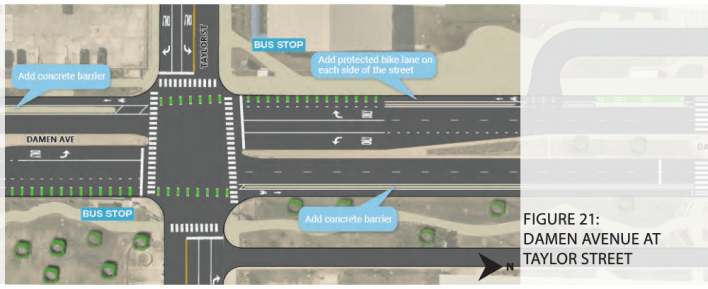
The fourth project improves walkability and ambiance on Harrison Street. West of Damen, the plan proposes bus bulbs, curb bump outs, speed humps, and landscaping with street furniture in front of buildings with large setbacks. The IMD Commission is also interested in working with landlords to remove extraneous curb cuts and limit vehicle access to parking lots from Harrison, diverting cars to enter and exit lots from side streets where possible.
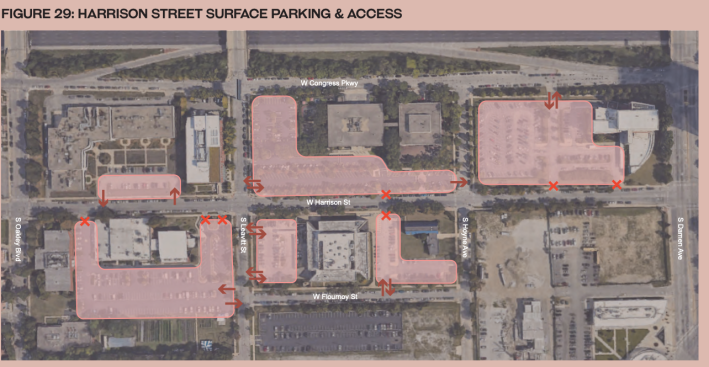
Harrison is calmer east of Damen, having benefitted from a 2018 bike and pedestrian plan created by Rush University Medical Center. Proposed changes on this section of Harrison are more modest: improved landscaping, removal of a steep vehicle ramp that impedes pedestrians at 1750 West Harrison, and a button-activated Pedestrian Hybrid Beacon for people crossing between Stroger Hospital and the Blue Line.
The last project is a series of interventions to slow drivers exiting the Eisenhower and improve pedestrian safety on Congress Parkway. Rumble strips on the I-290 exit ramps at Damen and Paulina Street, along with reduced curb radii, new signage and pavement markings would signal drivers to slow down as they merge onto Congress.
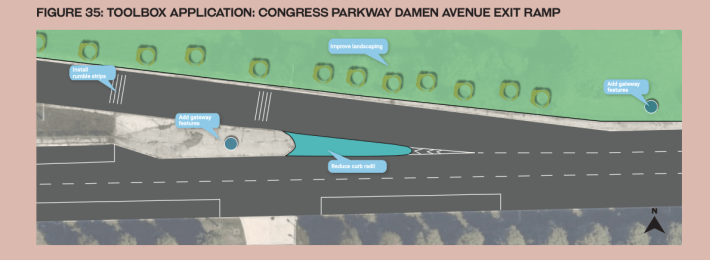
Many intersections on Congress lack crosswalks and ADA ramps – a particularly dangerous situation for Blue Line riders going to and from the Illinois Medical District station. The plan calls for installation of raised crosswalks, ramps and curb bump outs at all intersections. Narrowed travel lanes, landscaping and speed feedback signs are recommended along the parkway to encourage drivers to travel at the 20mph speed limit.
Because the IMD Commission will need to partner with city, county and state transportation departments, two Aldermanic offices, and private landowners on this plan, its full realization is likely several years away. However, all five projects are proposed with short-, medium- and long-term action steps. A section dedicated to “quick wins” lists relatively affordable and simple improvements that could be made in short order, like the closure and installation of street art on Wolcott, tree planting, and addition of wayfinding signs throughout the IMD. Hopefully, we’ll see some of these improvements to beautify and pacify the medical heart of the city soon.
Read the full IMD Bicycle and Pedestrian Safety Action Plan here.





